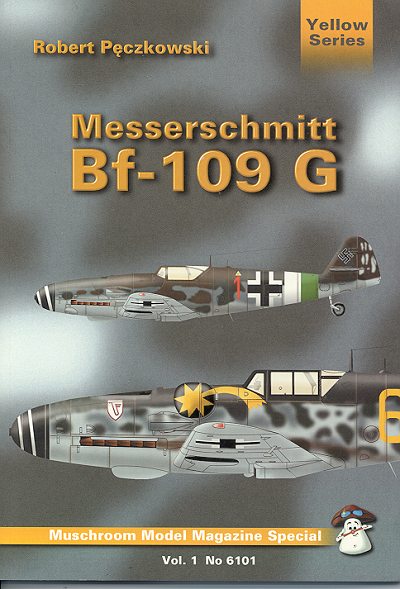|
BOOK: |
Messerschmitt
Bf-109G |
|
BY: |
Robert Peczkowski |
|
PUBLISHER
/PRICE: |
Mushroom Models
Publications
$? |
|
REVIEW BY: |
Scott
Van Aken |
|
NOTES: |
# 6101 |
 From Mushroom Model Publications comes
another in a series of special books. This particular book is on probably one of
the most modeled WWII aircraft: the Bf-109G. The number of permutations of the G
series is mind-boggling and confusing to those who are new to the study of the
109G and this book does a lot to straighten things out. Like the similar
book on the 109E, this book has no pretext to being a history of the type or to
offer 'war stories'. It concentrates on the difference between the subtypes an
on that it does a superb job.
From Mushroom Model Publications comes
another in a series of special books. This particular book is on probably one of
the most modeled WWII aircraft: the Bf-109G. The number of permutations of the G
series is mind-boggling and confusing to those who are new to the study of the
109G and this book does a lot to straighten things out. Like the similar
book on the 109E, this book has no pretext to being a history of the type or to
offer 'war stories'. It concentrates on the difference between the subtypes an
on that it does a superb job.
As with the previously
reviewed 109E book, this one uses museum aircraft and warbirds to illustrate a
number of the various bits and pieces of the plane. It also has a number of very
good illustrations from the handbook of maintenance to use to show differences.
There are also period photographs that are used where applicable. In addition,
there are a number of super line drawings to help you note the parts of the
plane that have changed from one sub-version to the next.
Unlike the 109E book, there
is not a separate section of closeups. That is because of the huge number of
aircraft in the G series. As a result, the book is 109G sub-types from cover to
cover. It starts with the 109G-1 and continues to the G-12. A chart of the
various modifications to the subtypes (Rustsatz and Umbausatz; or /R and /U as
suffixes to the designations). These modifications could be made in the field (Rustsatz)
or were the more involved ones done at the factory (Umbausatz).
There is a final section
devoted to the G-10. This is probably the most involved of the sub-types. All
G-10s were rebuilt from G-6 airframes and included a number of changes and
modifications to bring the planes up to nearly 109K standards. G-10s in many
cases came off the assembly lines after the K models and were basically an
effort to use up all available stocks of 109G parts and pieces.
In addition to the superb
photos and drawings, there are a number of equally well done color profiles.
Whether you are new to the 109G or just looking for an easy to use guide to the differences.
This is a book that belongs in your library.
It is hoped that Mushroom
does a guide on other semi-confusing types like the Spitfire, Fw-190, Zero,
Ju-88, and Yak fighters.
In case you cannot already
guess, this book is highly recommended!
Please visit Mushroom Models
Publications at their website listed below if you cannot find them locally.
Many thanks to
Mushroom Model
Publications for providing the review copy. Your support is appreciated.
If you would like your product reviewed fairly and quickly by a
site that averages over 2,600 visits a day, please contact
me or see other details in the Note to
Contributors.
 From Mushroom Model Publications comes
another in a series of special books. This particular book is on probably one of
the most modeled WWII aircraft: the Bf-109G. The number of permutations of the G
series is mind-boggling and confusing to those who are new to the study of the
109G and this book does a lot to straighten things out. Like the similar
book on the 109E, this book has no pretext to being a history of the type or to
offer 'war stories'. It concentrates on the difference between the subtypes an
on that it does a superb job.
From Mushroom Model Publications comes
another in a series of special books. This particular book is on probably one of
the most modeled WWII aircraft: the Bf-109G. The number of permutations of the G
series is mind-boggling and confusing to those who are new to the study of the
109G and this book does a lot to straighten things out. Like the similar
book on the 109E, this book has no pretext to being a history of the type or to
offer 'war stories'. It concentrates on the difference between the subtypes an
on that it does a superb job.